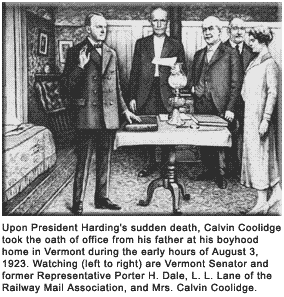 During the course of 1923, President Warren Harding began to be aware of scandals within his administration. Few believe that Harding himself was corrupt or that he had knowledge of the breadth of the offenders' misconduct. He did remark, however, that what kept him awake at night was not the actions of his political foes, but those of his friends.
In part to escape from those worries, Harding and his wife departed on a trip to Alaska. He made many stops along the way and delivered a number of speeches. On the return trip in late July, Harding clearly was not well and he suffered an attack of food poisoning in Seattle. Several days later in San Francisco, the president died.
On August 3, Vice President Calvin Coolidge took the oath of office from his father, a small town justice of the peace in Vermont.
A large funeral was held for Harding and prominent Americans made the obligatory laudatory remarks about the departed leader. The public was indeed shocked by Harding’s death, but more by its unexpected nature than by a sense of loss of a revered leader. As time passed and news of the scandals came out, some Republican leaders were relieved that Harding was gone; his continuation in office may have threatened the party’s hold on power.
Rumors about the cause of death began to circulate almost immediately. Foremost among them was a poison theory, in which some speculated that Harding took his own life in despair over troubles within the administration; others suggested that Mrs. Harding poisoned her husband to end his unfaithfulness. Another theory pointed to unhappy cronies who feared that the president might make good on his promise to clean up his administration.
Recent scholarship has effectively scuttled such speculation.* The opening of Harding’s physician’s records indicates that the president had long suffered from high blood pressure and that a heart attack was the cause of death.
During the course of 1923, President Warren Harding began to be aware of scandals within his administration. Few believe that Harding himself was corrupt or that he had knowledge of the breadth of the offenders' misconduct. He did remark, however, that what kept him awake at night was not the actions of his political foes, but those of his friends.
In part to escape from those worries, Harding and his wife departed on a trip to Alaska. He made many stops along the way and delivered a number of speeches. On the return trip in late July, Harding clearly was not well and he suffered an attack of food poisoning in Seattle. Several days later in San Francisco, the president died.
On August 3, Vice President Calvin Coolidge took the oath of office from his father, a small town justice of the peace in Vermont.
A large funeral was held for Harding and prominent Americans made the obligatory laudatory remarks about the departed leader. The public was indeed shocked by Harding’s death, but more by its unexpected nature than by a sense of loss of a revered leader. As time passed and news of the scandals came out, some Republican leaders were relieved that Harding was gone; his continuation in office may have threatened the party’s hold on power.
Rumors about the cause of death began to circulate almost immediately. Foremost among them was a poison theory, in which some speculated that Harding took his own life in despair over troubles within the administration; others suggested that Mrs. Harding poisoned her husband to end his unfaithfulness. Another theory pointed to unhappy cronies who feared that the president might make good on his promise to clean up his administration.
Recent scholarship has effectively scuttled such speculation.* The opening of Harding’s physician’s records indicates that the president had long suffered from high blood pressure and that a heart attack was the cause of death.